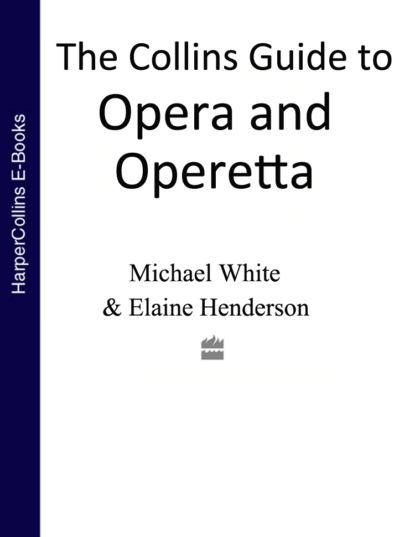По всем вопросам обращайтесь на: info@litportal.ru
(©) 2003-2024.
✖
The Collins Guide To Opera And Operetta
Автор
Год написания книги
2018
Настройки чтения
Размер шрифта
Высота строк
Поля
The Governess
Soprano
Miles
Boy Treble
Flora
Soprano
Mrs Grose, the housekeeper
Soprano
Miss Jessel, the former governess
Soprano
Peter Quint, the former servant
Tenor
Synopsis of the Plot
Setting: Bly, an English country house; mid-19th century
PROLOGUE A narrator introduces the story, telling us of how the young Governess has been engaged by the guardian of the two children, Miles and Flora. There is only one condition attached to the post: she must not trouble him.
ACT I The Governess is warmly welcomed at Bly and soon settles in. Slowly, however, she becomes aware of the increasing strangeness of the children’s behaviour and of a sinister atmosphere in the house, culminating in the momentary sighting of an unknown man at a window. On consulting the housekeeper, the Governess learns that this is Quint, the former manservant, now dead. Quint, she is told, was very close to Miles and had a relationship with Miss Jessel, the previous governess, who is also now dead. When the Governess finds both Flora and Miles communicating with these ghostly manifestations, she becomes seriously worried.
ACT II The Governess’ apprehensions reach a climax when she is confronted herself by Miss Jessel’s ghost and, despite Mrs Grose’s assurances that the children are in no danger, she determines to break the one condition of her employment and write to their guardian. Miles is deeply disturbed by this and, encouraged by Quint, he steals the letter before it can be sent. Flora disappears and is found by Mrs Grose and the Governess by the lake, communicating with Miss Jessel, whom Mrs Grose cannot see. Flora denies Miss Jesseľs presence and turns bitterly on the Governess before Mrs Grose takes the girl back to the house. That night Mrs Grose stays with Flora and is horrified by the child’s dreams; she decides to take her right away. Left alone with Miles, the Governess urges him to tell her what is in his mind but Quint appears, uttering warnings, and the boy is torn between the two of them. The conflict is too great and he collapses and dies in the Governess’ arms.
Music and Background
The most elegantly organised of all Britten’s operas, The Turn of the Screw is a small-scale chamber piece with thirteen instruments in the orchestra and a chilling intensity that delivers powerful emotions in a controlled way. The story is organised into short scenes linked by instrumental interludes and, musically, each scene is a variation on a twelve-note theme whose constant adaptations ‘turn the screw’ of the score in just the manner of Henry James’ title. As so often in Britten, the story concerns the corruption of innocence, but the (literally) haunting beauty of the highly embellished writing for the male ghost, Peter Quint, presents him as an ambiguously attractive character with whom the audience is clearly meant to feel some sympathy.
Highlights
Miles’ unsettlingly innocent solo in the Act I Lesson Scene, ‘Malo I would rather be’; the ghosts’ duet at the beginning of Act II, culminating in the line (borrowed from Yeats) ‘The ceremony of innocence is drowned’.
Recommended Recording
Peter Pears, Jennifer Vyvyan, David Hemmings, English Opera Group/Benjamin Britten. Decca 425 672-2. The original cast recording made in 1955 and never bettered.
Alfredo Catalani (#ulink_c8ef94ea-52ed-515e-b17d-a4e69c8bf7bb)
(1854–93)
Dejanice (1882)
Loreley (1879)
La Wally ( 1891)
Born in Lucca, educated in Paris and settling finally in Milan, where he became professor of composition at the conservatoire, Catalani had the misfortune to be a slightly older contemporary of Puccini who outclassed and overshadowed him. A lifelong invalid, his early death at thirty-nine left him with just one opera which survives in (fairly) regular repertory, La Watty. Its Nordic theme is typical of the German Romantic interests that make the music of this Italian composer unusual for its place and time.
La Wally (#ulink_bb2cc822-f2ec-5745-b375-f53357087d8f)
FORM: Opera in four acts; in Italian
COMPOSER: Alfredo Catalani (1854–93)
LIBRETTO: Luigi Illica; after W. von Hillem’s story
FIRST PERFORMANCE: Milan, 20 June 1892
Principal Characters
Wally
Soprano
Stromminger, her father and a rich landowner
Bass
Hagenbach
Tenor
Gellner
Baritone
Afra, proprietress of the inn
Contralto
Walter, a wandering player
Soprano
Synopsis of the Plot
Setting: The Swiss Tyrol; 1800
ACT I Wally has fallen in love with Hagenbach, the son of her father’s old enemy, although her feelings are not reciprocated. Gellner, who wants to marry Wally, warns Stromminger of his daughter’s feelings towards Hagenbach, and Stromminger’s response is to order Wally to marry Gellner within the month or leave his house. Wally leaves to live on the mountain.









